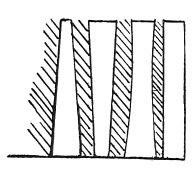
The Da Vinci Notebooks at sacred-texts.com
The ancient architects ...... beginning with the Egyptians (?) who, as Diodorus Siculus writes, were the first to build and construct large cities and castles, public and private buildings of fine form, large and well proportioned .....
The column, which has its thickness at the third part .... The one which would be thinnest in the middle, would break ...; the one which is of equal thickness and of equal strength, is better for the edifice. The second best as to the usefulness will be the one whose greatest thickness is where it joins with the base.
The capital must be formed in this way. Divide its thickness at the top into 8; at the foot make it 5/7, and let it be 5/7 high and you will have a square; afterwards divide the height into 8 parts as you did for the column, and then take 1/8 for the echinus and another eighth for the thickness of the abacus on the top of the capital. The horns of the abacus of the capital have to project beyond the greatest width of the bell 2/7, i. e. sevenths of the top of the bell, so 1/7 falls to the projection of each horn. The truncated part of the horns must be as broad as it is high. I leave the rest, that is the ornaments, to the taste of the sculptors. But to return to the columns and in order to prove the reason of their strength or weakness according to their shape, I say that when the lines starting from the summit of the column and ending at its base and their direction and length ..., their distance apart or width may be equal; I say that this column ...
72:395 : See Pl. CIII, No. 3, where the sketches belonging to lines 10--16 are reproduced, but reversed. The sketch of columns, here reproduced by a wood cut, stands in the original close to lines 5--8.